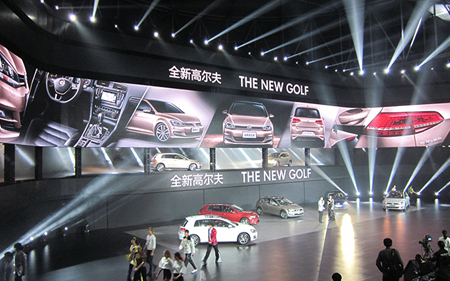Flexible LED display screen is a rapidly developing new display technology in recent years. It has the advantages of light weight, thinness, and easy portability. It can change its shape by bending, folding, stretching, etc., making it adaptable to different application scenarios. It can meet various shapes and sizes. The display requirements, therefore, flexible LED display screen has a wide range of applications in outdoor advertising, exhibitions, performances, sports venues, and other fields. When we choose a flexible LED display screen, it is also very important to learn how to judge its quality. Do you know how to judge the quality of a flexible LED display screen? The following ONUMEN will introduce to you:

Methods for judging the quality of flexible LED display screen:
Flexible LED display screens' surface flatness is required to have an error not exceeding 1mm, to ensure that the product does not distort the image during display. The flatness is directly related to the manufacturer's production process. Otherwise, local protrusions or depressions can cause blind angles in the visual angle of the flexible LED display screen.
White balance effect is a very important indicator for flexible LED display screens. In color science, when the ratio of red, blue, and green primaries is 14:60:16, pure white will be displayed. If the actual ratio deviates slightly, white balance deviation will occur. Generally speaking, it is important to note whether there is a bluish or greenish hue in white. The quality of white balance mainly depends on the control system of the flexible LED display screen, and the color reproduction of the chip will also have a certain impact.
Color reproduction primarily refers to the ability of a flexible LED display screen to accurately reproduce colors. In other words, the colors displayed on a flexible LED display screen should closely match the colors of the source material to ensure a realistic image.
The LED display brightness of a flexible LED display screen is directly related to the LED core used, and the size of the viewing angle directly impacts the number of viewers. Therefore, in theory, a larger viewing angle is better. The brightness and viewing angle of a flexible LED display screen have a significant impact on its application performance and user experience. An ideal flexible LED display screen should have sufficient brightness to be clear in various environments and provide a large viewing angle, allowing viewers to see clear images from any angle. Only when brightness and viewing angle meet the requirements can a flexible LED display screen truly fulfill its role in information dissemination and attract the attention of more viewers.
In summary, these are methods to evaluate the quality of a flexible LED display screen. In addition to these factors, one should also consider brightness, contrast, packaging technology, external quality, presence of color blocks, mosaic patterns, and dead pixels. Only by considering these aspects comprehensively and carefully can one make a better judgment about the quality of a flexible LED display screen.